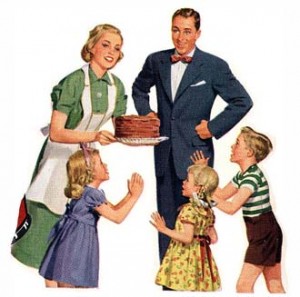Helmet? Check. Mouth guard? Check. Boxing gear? Check.
Okay, I think I’m ready to tackle this issue again.
If you’re a blogger and you want to say anything about gender roles, you better prepare yourself for a “whole lot of ugly coming at you from a never-ending train of stupid.”
Anyone who challenges traditional gender roles is going to get sandwiched with opposition. And anyone who defends traditional gender roles is going to find himself/herself in a similar BLT of aversion. Why is this such a “touchy” subject? I have my speculations.
But first! A story!
Yesterday, it being August, and I being a college student with nothing better to do in August, spent quite a bit of time perusing the comments sections of two different blogs who both wrote about gender-related issues (and came to different conclusions). Eventually, I came across this comment from a man who was against feminism and the smashing of gender roles.
“Masculinity and femininity is a dance, not a wrestling match. In a dance, one partner leads, the other follows, but each must give and take. Nobody can do anything without caring about the feelings and the needs of the other.
Another way to say it is that being male and being female is an art, not a science. You’ve got to work it out yourself. But there are general rules and boundaries to observe…Cacophonous music is pointless; it doesn’t mean that there is only one way to make music.”
My first reaction was this- I got angry. I thought, “How ignorant is this person?” Does he even know ANYTHING about cacophonous music?”
That’s right. My music historian instincts kicked in, I forgot all about gender roles, and my brain screamed about, “Cacophonous music is NOT pointless!”
I apologize for my lack of grace toward this poor man. Seriously, I’m sure one of the sins that Jesus had to die for was my music snobbery. But, after I got over my initial frustration, I began to make a connection, and I just wanted to share it with you all!
But first, a brief history of Western art music!
Back in the 1700s, when Mozart, Haydn, and all those other guys in powdered wigs were popping out symphonies left and right, art music had some specific rules. And people followed those rules almost completely (stepping out of line only rarely to liven things up) and made music that sounded like this:
http://www.youtube.com/watch?v=GT7_Y1pIBb4
Isn’t that lovely? It’s pleasant, it’s understandable, it’s familiar, it’s paints a pretty picture in one’s mind. That’s because it (usually) follows the rules- the chords stay in their proper place and make everything sound pretty.
But some composers got tired of following the rules. So, little by little, they started getting more rebellious. And as composers like Beethoven and Berlioz and Wagner broke more and more rules, their music began to sound more and more cacophonous (there’s that word again!), meaning that it began to sound more harsh and dissonant.
Because people were so used to music playing by the rules, when composers broke them, it sounded strange and dissonant to listeners. Some listeners didn’t mind because the music still had some structure. But others accused these composers of ruining music. How dare they not follow the rules!
And then, at beginning of the 1900s, in walks Arnold Schoenberg.
Schoenberg is my favorite composer, and historians consider him to be one of the most influential composers of all time. But you’ve probably never heard of him. Not many people like his music.
He wasn’t satisfied with pleasant music, with chords that “knew their place” and followed the rules. No!
He proclaimed an “emancipation of the dissonance” and freed chords from the musical hierarchy. He created a new kind of music where chords were no longer dependent on other chords in order to be musical. Chords could sound for themselves! And this new music sounded a bit like this:
http://www.youtube.com/watch?v=DUHn7knkrLc
Cacophonous. Dissonant. A first time listener might say, “ugly,” “weird,” or “unnatural” (if you liked this piece the first time hearing it, you have a more tolerable ear than I, my friend).
The harshness, the lack of familiarity scares some listeners even today. It forces them to question everything they thought they knew about music. So most people just dismiss it as “pointless.”
But you know what? I learned that Schoenberg piano piece last year- I practiced it for hours everyday. I got to know it. I saw where it was coming from. And, finally, I experienced it. Now it sends chills down my spine and brings tears to my eyes.
I can’t listen to it and hear anything but overwhelming beauty.
And now, a point to all this!
Somewhere in the history of humankind, someone decided that there’s gonna be some rules ’round here involving gender. Men, take the lead. Women, you be the back-up singers.
And those rules became pleasant, familiar, and they painted a lovely picture:
 But some women got tired of staying in their “proper” place. They wanted to stand alone as humans. To be able to make music without being dependent on a man.
But some women got tired of staying in their “proper” place. They wanted to stand alone as humans. To be able to make music without being dependent on a man.
They wanted cacophony!
But people didn’t find this picture to be quite as pleasant:

Some people’s ears weren’t ready for all this cacophony. And some people’s ears still aren’t ready. ‘Cause living in a world with out rules about gender? That’s messy, and that’s scary.
It asks women to find new ways to validate themselves- not just as wives or mothers or girlfriends. It forces them to make their own music- songs and stories where they are the main character, not a supporting role.
That’s scary. That’s messy. That’s cacophonous.
But it’s not pointless.
It asks men to refine what masculinity means to them. It asks them to share the spotlight. To give up some of their power and leadership and still somehow find a way to feel like a man.
That’s scary. That’s messy. That’s cacophonous.
But it’s not pointless.
And it asks a long-time patriarchal society and church to change some of the ways that they’ve been functioning for years.
That’s scary. That’s messy. That’s cacophonous.
But, pointless? No.
We need people who are willing to experience the cacophony that results when the genders become equalized. We need people who are willing to accept a new definition of “music” in relationships- one that will sound harsh and dissonant at first, but will eventually introduce us to rich and beautiful harmonies that we never knew were possible.
Who’s with me?
How about you, readers? How do you feel about traditional gender roles (go ahead and disagree! I promise to be nice!)? And if you disagree with me, how do you feel about the anonymous commenter that I quoted above’s flexible and improvisational approach to complementarianism? I don’t agree, but I do think that guy’s got style!











